Survival prospects for the honeybee (Apis mellifera) look increasingly promising as entomologists and beekeepers have reported a dramatic increase in the population numbers of these essential insects in North America and Europe. Honeybees, which are the predominant pollinators of numerous economically important plants and crops, have suffered significant losses over the past few decades as a result of a variety of factors, including colony collapse disorder (a detrimental condition of unknown etiology in honeybee colonies that is characterized by a rapid loss of the adult bee population), parasitic Varroa mites, exposure to insecticides and pesticides, and viral pathogens. In order to reduce these losses, beekeepers have improved the conditions of their hives and have attempted to eliminate the stressors to which bees are often subjected in their daily lives. These modifications appear to have been successful. For example, the number of commercial honeybee colonies in the United States increased by 3% in a 12-month period from April 2016 to April 2017, whereas the number lost to colony collapse disorder fell 27%. In addition, the loss due to Varroa mite infestations declined as well; although the mites remain the chief cause of bee deaths, 11% fewer colonies are being affected by these parasites. See also: Beekeeping; Colony collapse disorder; Die-off of bees; Hymenoptera; Insect diseases; Pathogen; Pollination; Social insects; Virus

The high reduction in the percentage of bee colonies lost to colony collapse disorder has allowed agricultural specialists and environmentalists to shift resources into examining the effects of pesticides and insecticides in areas in which honeybees are the chief pollinators. The question of pesticide use has been debated, and experts are divided over the actual consequences resulting from specific types of pesticides. For example, the insecticides known as neonicotinoids have come under scrutiny. Studies have suggested that bees that are exposed to these chemicals display impaired foraging behaviors, fail to locate their nest or hive, and have fewer offspring. However, other investigations point to a combination of other stressors (possibly including habitat loss and climate change) as the main culprits behind the decline in bee health. Still, farmers and beekeepers must be made aware of the potential impacts that may arise as a result of the use of any pesticides and insecticides, so coordination of the exact timing of chemical sprayings of fields that are set to be pollinated by honeybees is important. See also: Agricultural science (animal); Agricultural science (plant); Agriculture; Economic entomology; Environmental toxicology; Insecticide; Pesticide; Population ecology





